display Citroen C4 2016 2.G Workshop Manual
[x] Cancel search | Manufacturer: CITROEN, Model Year: 2016, Model line: C4, Model: Citroen C4 2016 2.GPages: 396, PDF Size: 10.22 MB
Page 182 of 396
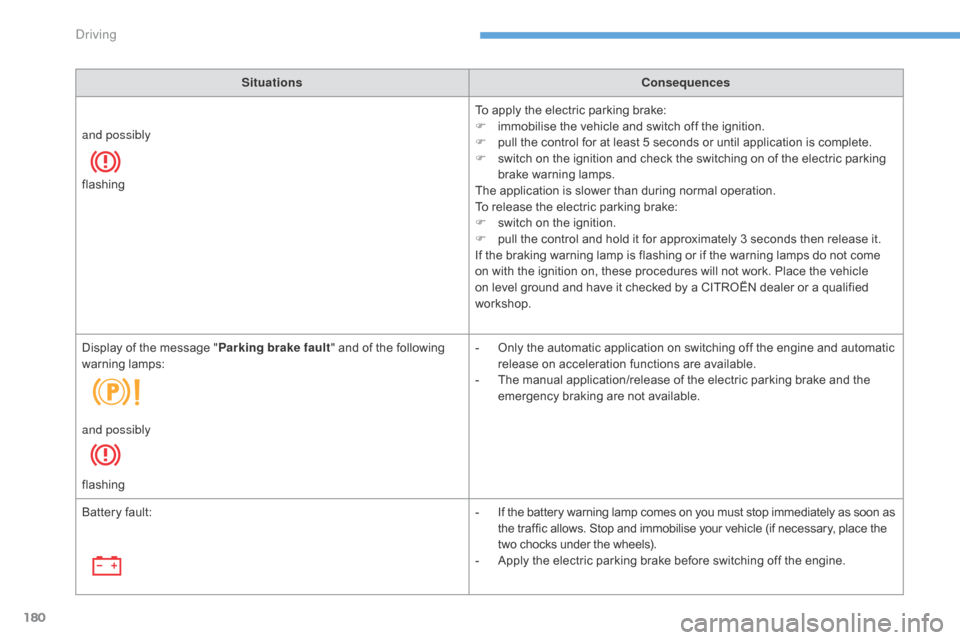
180
C4-2_en_Chap06_conduite_ed02-2015
SituationsConsequences
To apply the electric parking brake:
F
i
mmobilise the vehicle and switch off the ignition.
F
p
ull the control for at least 5 seconds or until application is complete.
F
s
witch on the ignition and check the switching on of the electric parking
b
rake warning lamps.
The
application is slower than during normal operation.
To
release the electric parking brake:
F
s
witch on the ignition.
F
p
ull the control and hold it for approximately 3 seconds then release it.
If
the braking warning lamp is flashing or if the warning lamps do not come
o
n with the ignition on, these procedures will not work. Place the vehicle
o
n level ground and have it checked by a CITROËN dealer or a qualified
w
orkshop.
and possibly
flashing
Display
of
the
message
" Parking brake fault "
and of the following
w
arning
lam
ps: -
O
nly the automatic application on switching off the engine and automatic
r
elease on acceleration functions are available.
-
T
he manual application/release of the electric parking brake and the
e
mergency braking are not available.
and possibly
flashing
Battery
fault: -
I
f the battery warning lamp comes on you must stop immediately as soon as
t
he traffic allows. Stop and immobilise your vehicle (if necessary, place the
t
wo chocks under the wheels).
-
A
pply the electric parking brake before switching off the engine.
Driving
Page 184 of 396

182
C4-2_en_Chap06_conduite_ed02-2015
Automatic gearbox
Gear selection gate
1. Gear selector.
2. B utton " T" (snow) .
3.
B
utton " S" (spor t) .
4.
P
osition markings for the gear selector.P.
Pa
rk.
-
I
mmobilisation of the vehicle, parking brake
o
n or off.
-
S
tarting the engine.
R.
R
everse.
-
R
eversing manoeuvres, vehicle stationary,
e
ngine at idle.
N.
N
eutral.
-
I
mmobilisation of the vehicle, parking brake
o
n.
-
S
tarting the engine.
D.
A
utomatic
ope
ration.
M.+ / -
M
anual operation with sequential
c
hanging of the six gears.
F
P
ush for wards to change up through the
g
ears.
or
F P ull backwards to change down through
t
he gears.
Gear selector positions
When you move the selector in the gate to select a position, the corresponding indicator
c
omes on in the instrument panel.
P
Pa
rk
R
Reverse
N
Neutral
D
D
rive (automatic driving)
S
Sp
ort
pro
gramme
T
S
now
pro
gramme
1 to 6
Gear engaged during manual operation
-
I
nvalid value during manual operation
Displays in the instrument
panelSix speed automatic gearbox which of fers a choice b
etween the comfort of fully automatic operation, e
nhanced by sport and snow programmes, and
t
he pleasure of manual gear changing.
Two
driving modes are offered:
-
a
utomatic operation for electronic
management
of the gears by the gearbox,
w
ith a sport
programme for a more
d
ynamic style of driving and a snow
programme
to improve driving when
t
raction is poor,
-
m
anual
operation for sequential changing
o
f the gears by the driver.
Driving
Page 185 of 396
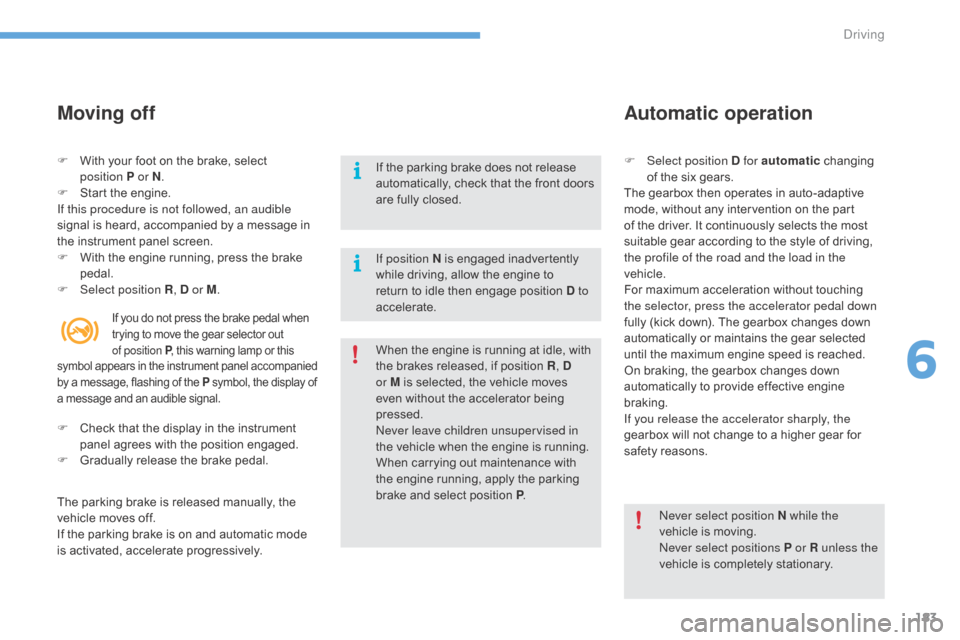
183
C4-2_en_Chap06_conduite_ed02-2015
Moving off
If position N is engaged inadvertently while driving, allow the engine to
r
eturn to idle then engage position D to
accelerate. F
Sel
ect position D for automatic
c
hanging
o
f the six gears.
The gearbox then operates in auto-adaptive
m
ode, without any intervention on the part
o
f the driver. It continuously selects the most
s
uitable gear according to the style of driving, t
he profile of the road and the load in the
vehicle.
For
maximum acceleration without touching
t
he selector, press the accelerator pedal down
fully
(kick down). The gearbox changes down
a
utomatically or maintains the gear selected
u
ntil the maximum engine speed is reached.
On
braking, the gearbox changes down
a
utomatically to provide effective engine
b
raking.
If you release the accelerator sharply, the
gearbox
will not change to a higher gear for
s
afety reasons.
When
the engine is running at idle, with
t
he brakes released, if position R,
D
or
M is selected, the vehicle moves
e
ven without the accelerator being
p
ressed.
Never leave children unsupervised in
the
vehicle when the engine is running.
When
carrying out maintenance with
t
he engine running, apply the parking
b
rake and select position P.
Never select position N while the
vehicle
is moving.
Never select positions P or R unless the
vehicle
is completely stationary.
If
the parking brake does not release
a
utomatically, check that the front doors
a
re fully closed.
F
W
ith
your
foot
on
the
brake,
select
p
osition
P or N
.
F
S
tart
the
engine.
If this procedure is not followed, an audible
signal
is
heard,
accompanied
by
a
message
in
t
he
instrument
panel
screen.
F
W
ith
the
engine
running,
press
the
brake
ped
al.
F
Sel
ect position R , D or M.
Automatic operation
The parking brake is released manually, the v
ehicle moves off.
If
the parking brake is on and automatic mode
i
s activated, accelerate progressively.
If you do not press the brake pedal when trying to move the gear selector out o
f position P ,
this warning lamp or this
s
ymbol
ap
pears
in t
he
in
strument
pan
el
a
ccompanied
b
y
a
message, flashing of the P
symbol, the display of
a
message
and an audible signal.
F Check that the display in the instrument p
anel agrees with the position engaged.
F
G
radually release the brake pedal.
6
Driving
Page 187 of 396
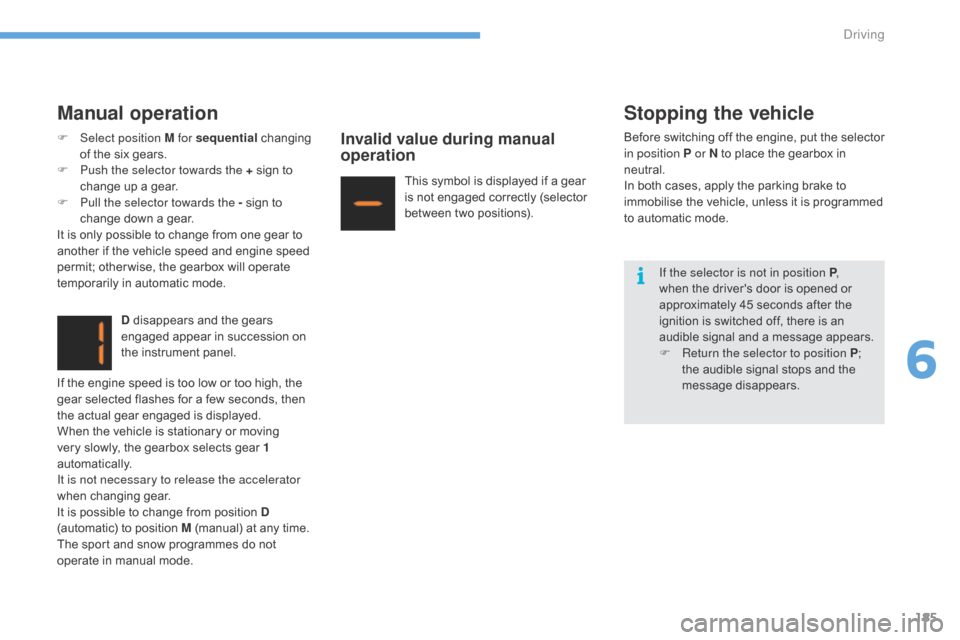
185
C4-2_en_Chap06_conduite_ed02-2015
Manual operation
D disappears and the gears engaged appear in succession on
t
he instrument panel.
Invalid value during manual
operation
This symbol is displayed if a gear is not engaged correctly (selector
b
etween two positions).
Stopping the vehicle
If the selector is not in position P ,
when the driver's door is opened or
a
pproximately 45 seconds after the
i
gnition is switched off, there is an
a
udible signal and a message appears.
F
R
eturn the selector to position P ;
t
he audible signal stops and the
m
essage
d
isappears.
F
Sel
ect position M for sequential
c
hanging
o
f
the
six
gears.
F
P
ush the selector towards the +
sign
to
c
hange
up
a
gear.
F
P
ull the selector towards the -
sign
to
c
hange
down
a
gear.
It
is
only
possible
to
change
from
one
gear
to
a
nother
if
the
vehicle
speed
and
engine
speed
p
ermit;
other wise,
the
gearbox
will
operate
t
emporarily
in
automatic
mode.
If
the
engine
speed
is
too
low
or
too
high,
the
g
ear
selected
flashes
for
a
few
seconds,
then
t
he
actual
gear
engaged
is
displayed.
When
the
vehicle
is
stationary
or
moving
v
ery
slowly,
the
gearbox
selects
gear
1
automatically.
It is not necessary to release the accelerator
when
c
hanging
g
ear.
It
is
possible
to
change
from
position
D
(automatic)
to
position
M
(manual)
at
any
time.
The
sport
and
snow
programmes
do
not
o
perate
in
manual
mode. Before
s
witching
o
ff
t
he
e
ngine,
p
ut
t
he
s
elector
i
n position P or N to place the gearbox in
neu
tral.
In
both cases, apply the parking brake to
i
mmobilise the vehicle, unless it is programmed
t
o
automatic mode.
6
Driving
Page 189 of 396
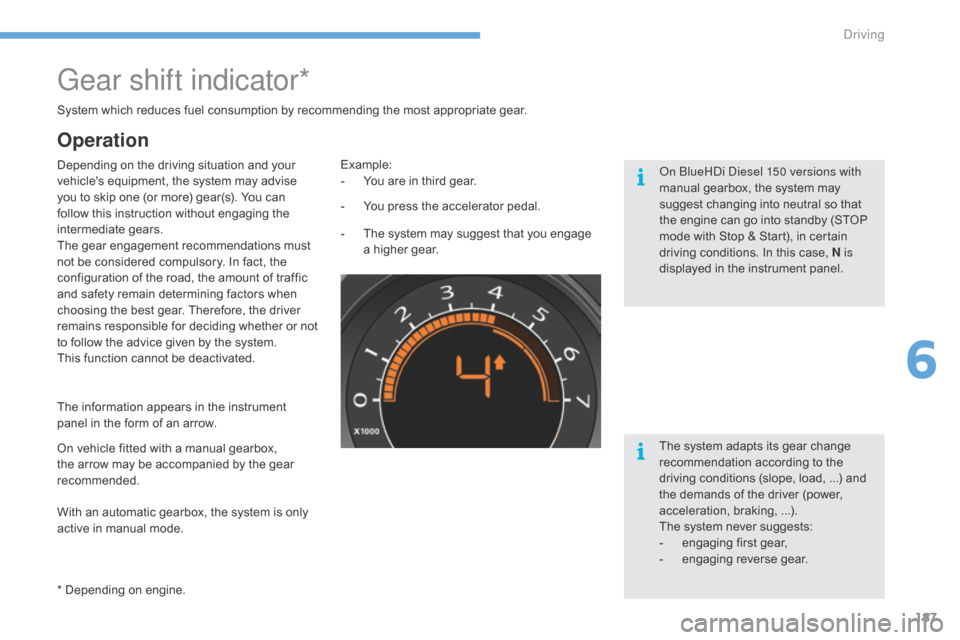
187
C4-2_en_Chap06_conduite_ed02-2015
Gear shift indicator*
Depending on the driving situation and your vehicle's equipment, the system may advise
y
ou to skip one (or more) gear(s). You can
f
ollow this instruction without engaging the
i
ntermediate
g
ears.
The
gear engagement recommendations must
n
ot be considered compulsory. In fact, the
c
onfiguration of the road, the amount of traffic
a
nd safety remain determining factors when
c
hoosing the best gear. Therefore, the driver
r
emains responsible for deciding whether or not
t
o follow the advice given by the system.
This
function cannot be deactivated. -
Y
ou press the accelerator pedal.
Example:
-
Y ou are in third gear.
-
T
he system may suggest that you engage
a
higher gear.
The
information appears in the instrument
p
anel in the form of an arrow.
System
which reduces fuel consumption by recommending the most appropriate gear.
With an automatic gearbox, the system is only
a
ctive in manual mode.
* Depending
on engine.
On
vehicle fitted with a manual gearbox,
t
he arrow may be accompanied by the gear
re
commended. The
system adapts its gear change
r
ecommendation according to the
d
riving conditions (slope, load, ...) and
t
he demands of the driver (power,
a
cceleration, braking, ...).
The
system never suggests:
-
e
ngaging first gear,
-
enga
ging
r
everse
g
ear.
Operation
On BlueHDi Diesel 150 versions with
manual gearbox, the system may
s
uggest changing into neutral so that
t
he engine can go into standby (STOP
m
ode with Stop & Start), in certain
d
riving conditions. In this case, N is
displayed
in the instrument panel.
6
Driving
Page 191 of 396
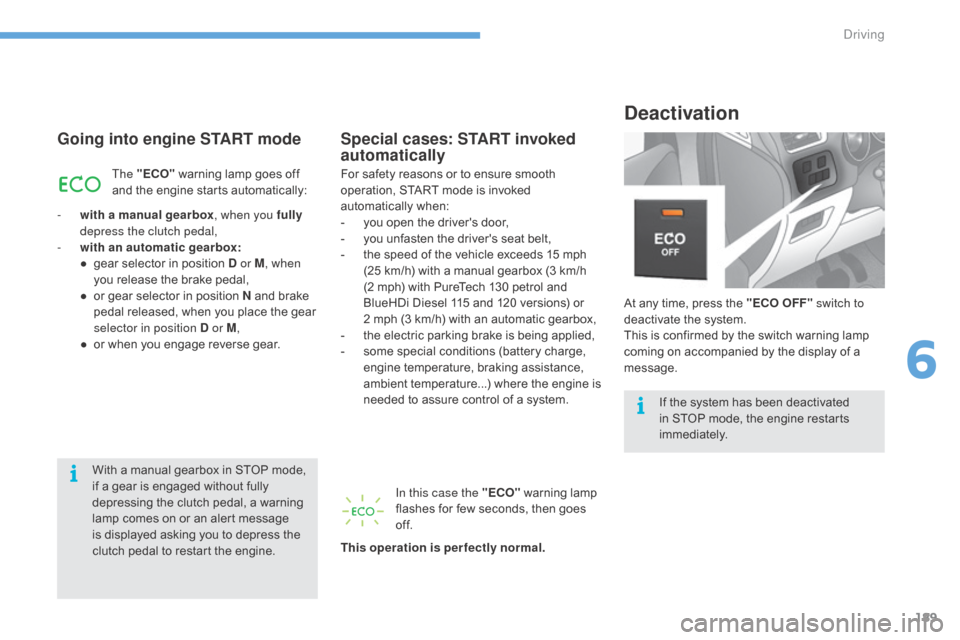
189
C4-2_en_Chap06_conduite_ed02-2015
Deactivation
Going into engine START mode
At any time, press the "ECO OFF" switch to
d eactivate the system.
This
is confirmed by the switch warning lamp
c
oming on accompanied by the display of a
m
essage.
Special cases: START invoked
automatically
The "ECO" warning lamp goes off a
nd the engine starts automatically:
-
w
ith a manual gearbox , when you fully
depress the clutch pedal,
-
w
ith an automatic gearbox:
●
g
ear selector in position D or M, when
you
release the brake pedal,
●
o
r
gear selector in position N and brake
p
edal released, when you place the gear
s
elector in position D or M ,
●
o
r
when you engage reverse gear.For
safety reasons or to ensure smooth o
peration, START mode is invoked
a
utomatically
w
hen:
-
y
ou open the driver's door,
-
y
ou unfasten the driver's seat belt,
-
t
he speed of the vehicle exceeds 15 mph
(
25 km/h) with a manual gearbox (3 km/h
(
2 mph) with PureTech 130 petrol and
B
lueHDi Diesel 115 and 120 versions) or
2 m
ph (3 km/h) with an automatic gearbox,
-
t
he electric parking brake is being applied,
-
s
ome special conditions (battery charge,
e
ngine temperature, braking assistance,
a
mbient temperature...) where the engine is
n
eeded to assure control of a system.
In this case the "ECO"
warning lamp
f
lashes for few seconds, then goes
o
f f.
This operation is perfectly normal.
With
a manual gearbox in STOP mode,
i
f
a
gear is engaged without fully
d
epressing the clutch pedal, a warning
l
amp comes on or an alert message
i
s
displayed asking you to depress the
c
lutch pedal to restart the engine. If
the system has been deactivated
i
n STOP mode, the engine restarts
i
mmediately.
6
Driving
Page 192 of 396
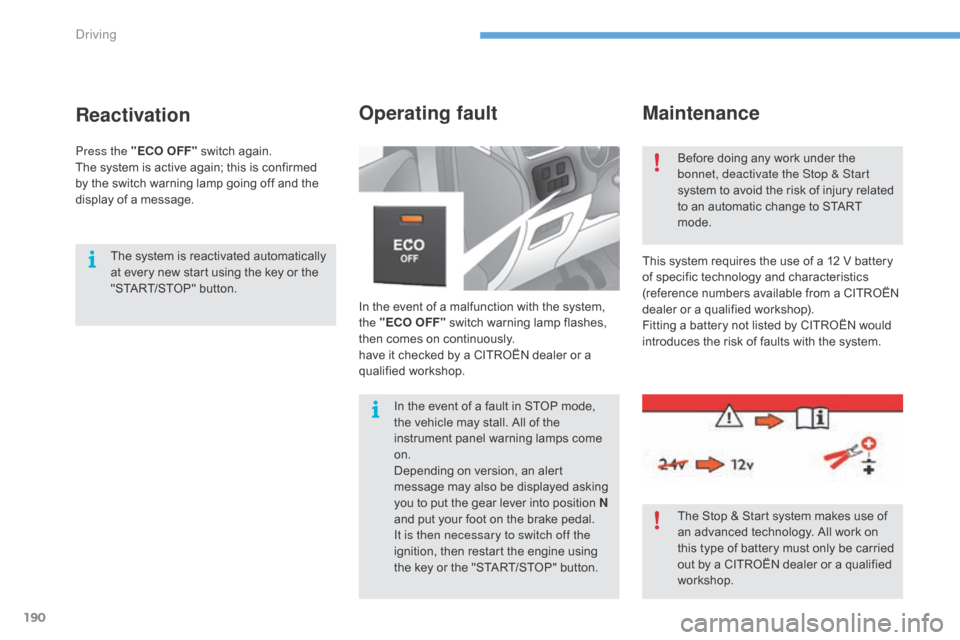
190
C4-2_en_Chap06_conduite_ed02-2015
Maintenance
In the event of a malfunction with the system, the "ECO OFF" switch warning lamp flashes,
t
hen comes on continuously.
have
it checked by a CITROËN dealer or a
q
ualified
w
orkshop.
Operating fault
This system requires the use of a 12 V battery of specific technology and characteristics
(
reference numbers available from a CITROËN
d
ealer or a qualified workshop).
Fitting
a battery not listed by CITROËN would
i
ntroduces the risk of faults with the system.
Before
doing any work under the
b
onnet, deactivate the Stop & Start
system to avoid the risk of injury related
t
o an automatic change to START
m
ode.
The Stop & Start system makes use of
a
n advanced technology. All work on
t
his type of battery must only be carried
o
ut by a CITROËN dealer or a qualified
w
orkshop.
In
the
event
of
a
fault
in
STOP
mode,
t
he
vehicle
may
stall.
All
of
the
i
nstrument
panel
warning
lamps
come
o
n.
Depending
on
version,
an
alert
m
essage
may
also
be
displayed
asking
y
ou
to
put
the
gear
lever
into
position
N
and
put
your
foot
on
the
brake
pedal.
It is then necessary to switch off the
ignition,
then
restart
the
engine
using
t
he
key
or
the
"START/STOP"
button.
Reactivation
The system is reactivated automatically a t every new start using the key or the
"
START/STOP" button.
Press the "ECO OFF"
switch again.
The
system is active again; this is confirmed
b
y
the
switch warning lamp going off and the
d
isplay of a message.
Driving
Page 195 of 396
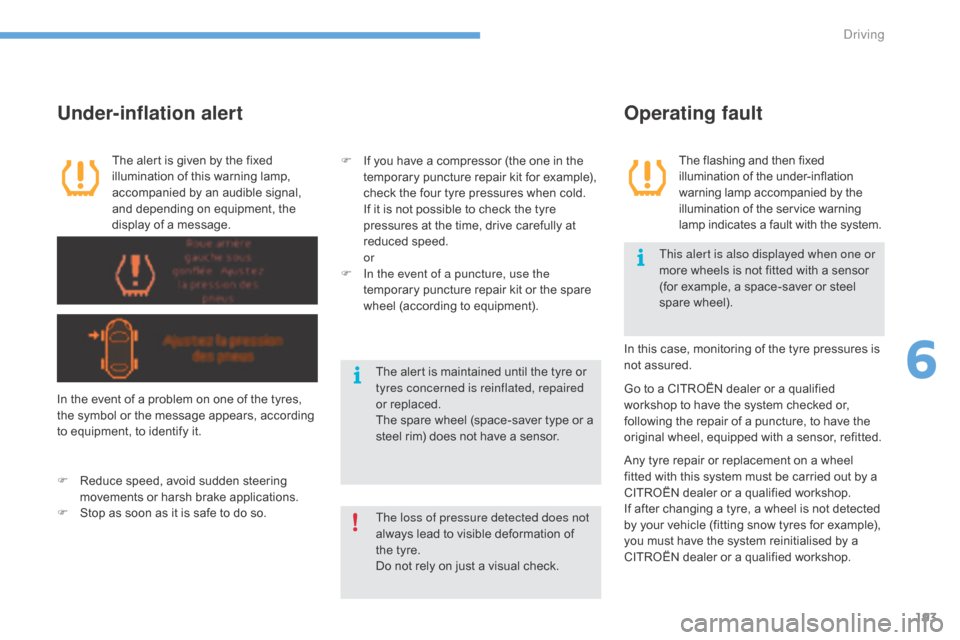
193
C4-2_en_Chap06_conduite_ed02-2015
The flashing and then fixed illumination of the under-inflation w
arning lamp accompanied by the
i
llumination of the service warning
l
amp indicates a fault with the system.
Operating fault
The alert is given by the fixed illumination of this warning lamp,
a
ccompanied by an audible signal,
a
nd depending on equipment, the
d
isplay of a message.
Under-inflation alert
In the event of a problem on one of the tyres, the symbol or the message appears, according
t
o equipment, to identify it.
F
R
educe speed, avoid sudden steering
m
ovements or harsh brake applications.
F
S
top as soon as it is safe to do so. In
this case, monitoring of the tyre pressures is
n
ot assured.
F
I
f you have a compressor (the one in the
t
emporary puncture repair kit for example),
c
heck the four tyre pressures when cold.
I
f it is not possible to check the tyre
p
ressures at the time, drive carefully at
r
educed
s
peed.
or
F
I
n the event of a puncture, use the
temporary puncture repair kit or the spare
w
heel (according to equipment).
Go to a CITROËN dealer or a qualified w
orkshop to have the system checked or,
f
ollowing the repair of a puncture, to have the
o
riginal wheel, equipped with a sensor, refitted.
Any
tyre repair or replacement on a wheel
f
itted with this system must be carried out by a
C
ITROËN dealer or a qualified workshop.
If
after changing a tyre, a wheel is not detected
b
y your vehicle (fitting snow tyres for example),
y
ou must have the system reinitialised by a
C
ITROËN dealer or a qualified workshop.
The loss of pressure detected does not
always
lead to visible deformation of
t
he tyre.
Do
not rely on just a visual check.This alert is also displayed when one or
more
wheels is not fitted with a sensor
(
for example, a space-saver or steel
spar
e
w
heel).
The alert is maintained until the tyre or t
yres concerned is reinflated, repaired
or replaced.
The
spare wheel (space-saver type or a
s
teel rim) does not have a sensor.
6
Driving
Page 200 of 396
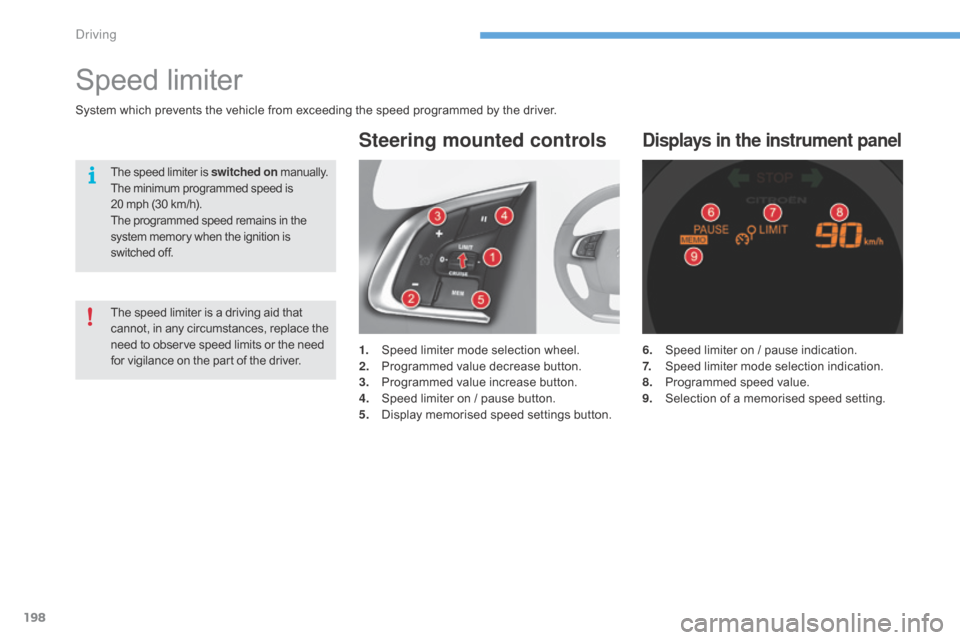
198
C4-2_en_Chap06_conduite_ed02-2015
6. Speed limiter on / pause indication.
7. S peed limiter mode selection indication.
8.
P
rogrammed speed value.
9.
S
election of a memorised speed setting.
Displays in the instrument panel
Speed limiter
1. Speed limiter mode selection wheel.
2. P rogrammed value decrease button.
3.
P
rogrammed value increase button.
4.
S
peed limiter on / pause button.
5.
D
isplay memorised speed settings button.
Steering mounted controls
System which prevents the vehicle from exceeding the speed programmed by the driver.
The speed limiter is switched on manually.
The minimum programmed speed is 2
0 mph (30 km/h).
The
programmed speed remains in the
s
ystem memory when the ignition is
s
witched off.
The speed limiter is a driving aid that cannot, in any circumstances, replace the n
eed to observe speed limits or the need
f
or vigilance on the part of the driver.
Driving
Page 201 of 396
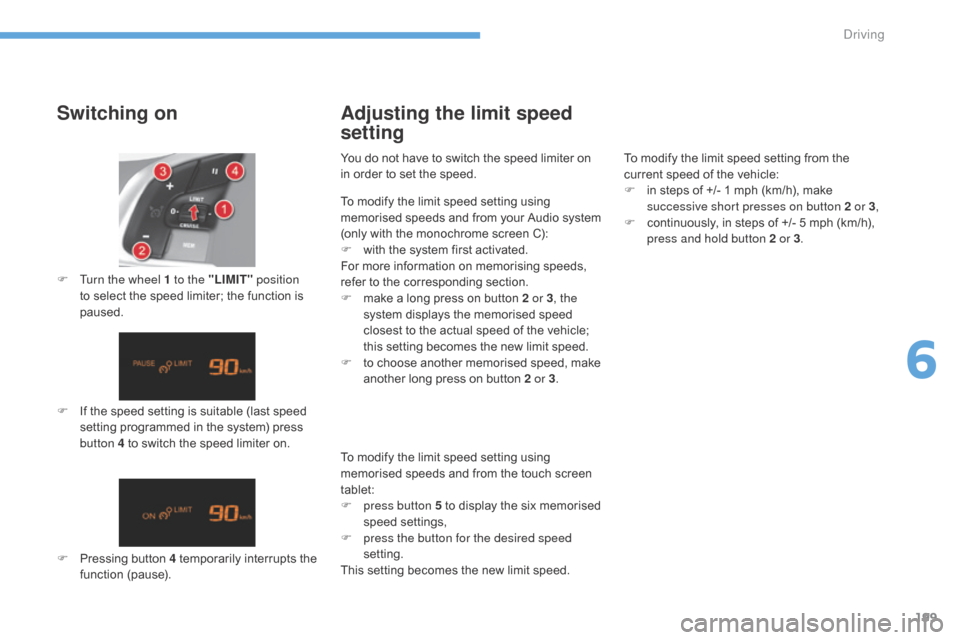
199
C4-2_en_Chap06_conduite_ed02-2015
Switching on
F If the speed setting is suitable (last speed s
etting programmed in the system) press
b
utton 4 to switch the speed limiter on.
F
T
urn the wheel 1 to the "LIMIT"
position
to select the speed limiter; the function is
pa
used.
F
P
ressing button 4 temporarily interrupts the
f
unction
(
pause).
Adjusting the limit speed
setting
You do not have to switch the speed limiter on in order to set the speed. To
modify the limit speed setting from the
c
urrent speed of the vehicle:
F
i
n steps of +/- 1 mph (km/h), make
s
uccessive short presses on button 2 or 3,
F
c
ontinuously, in steps of +/- 5 mph (km/h),
p
ress and hold button 2 or 3.
To
modify the limit speed setting using
m
emorised speeds and from the touch screen
t
ablet:
F
p
ress button 5 to display the six memorised
s
peed
se
ttings,
F
p
ress the button for the desired speed
setting.
This
setting becomes the new limit speed.
To
modify the limit speed setting using
m
emorised
s
peeds
a
nd
f
rom
y
our
A
udio
s
ystem
(
only with the monochrome screen C):
F
w
ith the system first activated.
For
more information on memorising speeds,
r
efer to the corresponding section.
F
m
ake a long press on button 2 or 3, the
system
displays the memorised speed
c
losest to the actual speed of the vehicle;
t
his setting becomes the new limit speed.
F
t
o choose another memorised speed, make
a
nother long press on button 2 or 3.
6
Driving